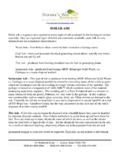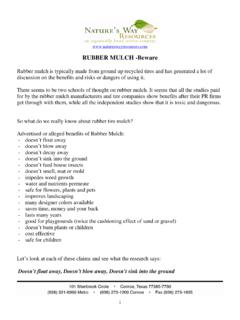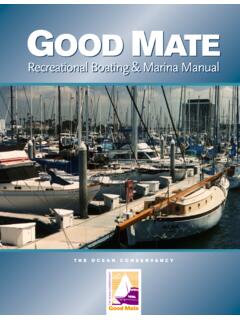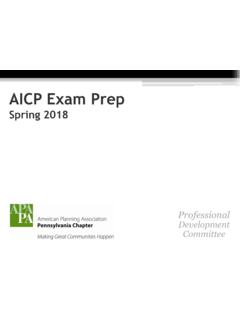Transcription of BOILER ASH - Nature's Way Resources
1 ASHB oiler ash is a generic term applied to many types of ash produced by the burning of variousmaterials. They are 4 general types of BOILER ash commonly available, each with its ownchemical and environmental characteristics:Wood Ash fromboilers where wood (or bark) is used as a heating sourceCoal Ash from coal powered electrical generating power plants, actually two forms,bottom ash and fly ashTire Ash produced from burning shredded tires for fuel in generating plantsIncinerator Ash produced from burning MSW (Municipal Solid Waste, ) as a waste disposal methodIncinerator Ash This type of ash is produced from burning MSW (Municipal Solid Waste, Garbage) as a waste disposal method by primarily converting many of the solids to gaseswhich are discharged into the air resulting in a large volume reduction of the material. Thegarbage is burned at a temperature of 1600-18000F which combusts most of the materialdestroying many toxic organics.
2 The resulting ash is a Type II material and is a mixture ofmany chemicals from the plastic, batteries, etc. that were in the garbage. It also containsnon-combustibles such as metals, glass, concrete, brick, etc. Often dioxins are formed in theash. Currently the ash has no beneficial re-use and is disposed of at special landfills at a costof $30-40 per ton. Chambers County has the only incinerator in this area and all the ash isdisposed of at their county Ash Used tires can no longer be disposed of in a landfill hence they must be handledby alternate disposal methods. One of these methods is to grind them up and burn them forfuel. Tires are made up of many chemicals some of which are toxic as well as the metalsfrom the steel belts to high levels of zinc. All the chemicals become concentrated in the a result of chemical leaching, phytotoxic effects are to be expected from the ash andpermanent damage to your soil would be , an ash residue is left behind, mainly of zinc oxide, titanium dioxide, iron, carbon and other materialsThe Seattle Times in July 1997 exposed the growing national practice of recycling industrialwastes- many containing toxicants, dioxin and even radioactive material- into agriculturalfertilizers.
3 Before The Times' series, few farmers were aware of the practice. Tire ash andfertilizers both fail tests for cadmium, which can be readily absorbed by plants andconcentrates in leaves, grain and fleshy fruits. The ash is a good source of zinc, which helpsplants grow- but it also contains the poisonous elements lead and cadmium. Millions ofdiscarded tires from the East Coast ended up in fertilizer sold in the West and three foreignnations, in violation of federal hazardous-waste laws. The ash is mixed with sulfuric acidand water to produce fertilizer granules sold to distributors who mixed it in blended productsfor farmers, nurseries and home gardeners. The buyers are not told the fertilizer was madefrom recycled waste. The granules are 20 percent zinc, which is commonly used in plantfood. But lead and cadmium, heavy metals of no benefit to plants or animals, are alsoincluded.
4 They weren't listed on the label or tested by regulators in any of the 10 states inwhich the product was Ash This type of ash is produced from burning coal for electrical power generationand is the waste product that results. There are two primary forms, bottom ash and fly ash accumulates at the bottom of the burner while fly ash is collected in the smokestack scrubber. They have very different chemical and physical properties and are theinorganic constituents of the burned fuel that are not completely combusted. Beneficial usesinclude making portland cement, mixing with concrete, and stabilizing soils for road Ash The scrubbers in the flue use a lime slurry to reduce the amount of sulfur dioxide(SO2) escaping to the atmosphere and other toxic materials. Arsenic, cadmium, copper,gallium, lead, antimony, selenium, zinc and other chemicals are commonly found toconcentrate in fly ash.
5 Due to the lime slurry used fly ash tends to be very alkaline (toxic).Also studies have found that as little as 8% fly ash by weight mixed with soil can increasethesalinity 5-6 times in a short period of time. It has also been found depending on applicationrates that fly ash suppresses beneficial microbes in the soil and as little as 10% can cause a50% reduction in microbial activity. In a few limited cases the boron present can in deficient soils when applied in small amounts. The exact properties vary withthetype coal burned and the type equipment Ash This is the most common type of ash as it is produced in very large of the coal burned ends up as bottom ash is toxic (mutagenic and carcinogenic) and contains many radioactive elements likeuranium and thorium along with arsenic and mercury. When used as a soil amendment manyspecies of plants suffer growth problems.
6 Some plants have been found to accumulate toxicamounts of selenium, manganese, aluminum and boron in their tissues. Small amounts of ashwhen leached have been found toxic to many animal species (fish and others) leading todeformities and death. Toxic material from coal ash has also been found in drinking waterfrom Ash Clean pure wood ash can be beneficial as a soil amendment replacing lime andproviding many trace elements. The chemical and physical properties vary greatlydepending on the species of wood burned and the temperature at which it is burned. Most ofthe wood ash produced (over 80%) is land applied in the Northeast United States and verylittle elsewhere. The first problem occurs since the nutrients in ash caneasily leach andpollute waterways. The ash dust is also toxic if breathed which is common. Even though itis illegal, it is very common for CCA, Creosote and Penta (pentachlorophenol) treated woodto be burned or ground up and used in mulch (or compost).
7 The copper, chromium andarsenic levels concentrate in the ash and are :To keep costs down and profits up some producers of mulch, compost, and other bagged soilamendments use various types of "fillers." These include sawdust, groundpallets, plywoodand glueboard dust (may contain dangerous chemicals), spent mushroom substrate that iscalled compost for marketing (high salts), paper mill sludges, bottom and fly ash fromboilers (turns material black), Ash (bottom ash)from coalis the most commonly used toxic industrial waste in theHouston area. It is so alkaline it will chemically burn mulch black in a few days. It is appliedto organic waste from pine bark to ground up wood to make it look black or tends to be high in salts and extremely alkaline. The products produced tend to bealkaline with high salt, with very high carbon to nitrogen ratios.
8 Some ashes may containlargeamounts of heavy metals that contaminate the mulch exceeding federal regulatory levels forsafety. These mulch products will often turn a bleached grayish color in a few weeks afterexposure to sunlightas the toxic chemicals leach into the many dealers and producers will use incorrect or misleading terminology. Someproducerssell products that use words like "Black" and "Humus" in their names. Theseproducts are often made from fresh pine bark fines, do not contain any humus, and arechemically burned to turn it black by addingthevery alkaline chemicals ( it is mixed withboiler ash which is very alkaline and contains high levels of salts). Other dealers will grindup old pallets, scrap wood, trees, etc. and mix it with fly ash or bottom ash then sell it asblack hardwood mulch. These type products are verypoor mulch choices and are often toxicto many plantsas well as people and pets.
9 People use them, but when the plants get sick anddie, they think "I just do not have a green thumb." People buy them because they are oftensold at bargain theyare not very cost : Black only occurs in nature when anaerobic conditions occur ( fermentation).When anaerobic decay occurs the good microbes die and pathogens grow in their are produced which are highly toxic to plant roots. Only 1 ppm (1 part per million)alcohol will kill plant roots! Good compost which is often called Black Gold is actually adeep chocolate brown when dry, the color of in all things, one gets what you pay for. As one crop and soil scientist(Texas A&M)says, "When dealing withbargains, let the buyer beware."References:Agricultural Utilization of Urban and Industrial By-Products, ASA (American Society ofAgronomy), CSSA (Crop Science Society of America), SSA (Soil Science Society ofAmerica), Special Publication Number 58 Symposium Proceedings, 1995 ISBN Amendments and Environmental Quality, Editor Jack E.
10 Rechcigl, University ofFlorida, CRC Lewis Publishers, 1995, ISBN 0-87371-859-3 Fly Ash Bilski, Alva, and K. S. Sajwan, pp. 327-363 Wood Ash Composition As A Function of Furnace Temperature, M. Misra, K. Ragland, andA. Baker, Department of Mechanical Engineering, University of Wisconsin-Madison,Biomass and Bioenergy, , No. 2, ,1993 Best Management Practices for Wood Ash as Agricultural Soil Amendment, M. Risse,University of Georgia College of Agriculture and Environmental Sciences, September 2002 Toxic Timber, , Technical Report March 2005 Regulatory Concerns Withthe Management and Disposal of CCA Treated Wood, WilliamHinkley, Bureau of Solid and Hazardous Waste, Florida Department of EnvironmentalProtection, July Burning Question, Tux Turkel, Portland Press Herald, February 2006 Wood and Mill YardDebris Technical Guidance Manual, Ed Hale, Panhandle HealthDistrict, February 1998 Overview of Wood-Fired BOILER Use in West Virginia, Fact Sheet 16, AppalachianHardwood Center, April 1998 Report to the Joint Standing Committee on Natural Resources Concerning Safe Managementof Arsenic Treated Wood Wastes, Maine Department of Environmental Protection.







